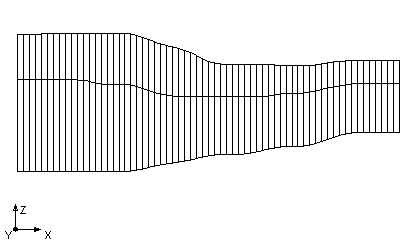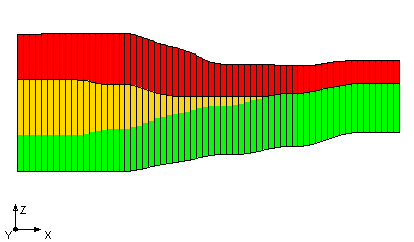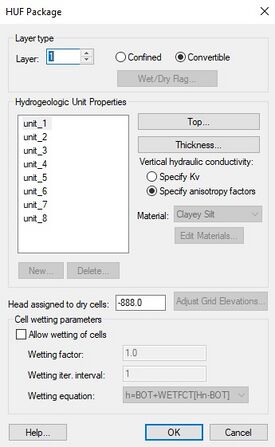GMS:HUF Package: Difference between revisions
From XMS Wiki
Jump to navigationJump to search
No edit summary |
|||
| (10 intermediate revisions by 4 users not shown) | |||
| Line 1: | Line 1: | ||
{{MODFLOW Links}} | {{MODFLOW Links}} | ||
__NOTOC__ | __NOTOC__ | ||
The Hydrogeologic-Unit Flow (HUF) package is an alternative to the [[GMS:BCF Package|BCF]] and [[GMS:LPF Package|LPF]] packages. It allows the user to define the vertical elevations of the hydrogeology independent of the 3D grid as shown in the figures below. Notice in the figures below that the second grid layer has more than one hydrogeologic unit associated with it. | |||
<gallery mode=packed heights="200px" style="text-align:left"> | |||
Image:huf_grid.png|Side view of MODFLOW grid | |||
Image:huf_grid_fill.png|HUF units displayed in MODFLOW grid | |||
</gallery> | |||
[[File:MODFLOW-HUF.jpg|thumb|275 px|The MODFLOW ''HUF Package'' dialog.]] | [[File:MODFLOW-HUF.jpg|thumb|275 px|The MODFLOW ''HUF Package'' dialog.]] | ||
With the HUF package, the user then defines the top and thickness of each of the hydrogeologic units. A material is associated with each unit and the hydraulic properties (HK, VK...) are assigned to the material. The top and thickness arrays can be automatically generated from solids using the [[GMS:Solids to HUF|'''Solids → HUF''']] command from the ''Solids'' menu or from boreholes with the '''Horizons → HUF''' command in the ''Boreholes'' menu. | With the HUF package, the user then defines the top and thickness of each of the hydrogeologic units. A material is associated with each unit and the hydraulic properties (HK, VK...) are assigned to the material. The top and thickness arrays can be automatically generated from solids using the [[GMS:Solids to HUF|'''Solids → HUF''']] command from the ''Solids'' menu or from boreholes with the '''Horizons → HUF''' command in the ''Boreholes'' menu. | ||
Another feature in GMS that incorporates the HUF package is the ability to use TPROGS to [[GMS:T-PROGS| | Another feature in GMS that incorporates the HUF package is the ability to use TPROGS to [[GMS:T-PROGS|generate HUF data]]. | ||
Once the HUF package has been chosen using the ''Packages'' dialog, the ''HUF Package'' dialog can be accessed through the '''HUF package''' command in the ''MODFLOW'' menu. The following options are available in the ''HUF Package'' dialog. | Once the HUF package has been chosen using the ''Packages'' dialog, the ''HUF Package'' dialog can be accessed through the '''HUF package''' command in the ''MODFLOW'' menu. The following options are available in the ''HUF Package'' dialog. | ||
=== Layer type === | |||
This radio group selects the layer type for the current layer. By default, all layers are convertible. Only one layer type can be assigned to each grid layer. | |||
=== Layer === | === Layer === | ||
This field displays the current layer. Selecting any of the input array buttons will display the corresponding layer initially. For multiple layer models, this field can be incremented or decremented to show other layers. | This field displays the current layer. Selecting any of the input array buttons will display the corresponding layer initially. For multiple layer models, this field can be incremented or decremented to show other layers. | ||
=== Hydrogeologic Unit Properties === | === Hydrogeologic Unit Properties === | ||
The window lists the names of the currently defined units. The '''Top and Thickness''' button bring up the [[GMS:MODFLOW Array Editor|MODFLOW Array Editor]]. For each hydrogeologic unit the user can specify if vertical hydraulic conductivity (VK) or vertical anisotropy (VANI) will be used. The material selection box | The window lists the names of the currently defined units. The '''Top and Thickness''' button bring up the [[GMS:MODFLOW Array Editor|MODFLOW Array Editor]]. For each hydrogeologic unit the user can specify if vertical hydraulic conductivity (VK) or vertical anisotropy (VANI) will be used. The material selection box shows the material assigned to the unit. The material properties (HK, VK...) are edited by selecting the '''Edit Materials''' button. | ||
=== Vertical hydraulic conductivity === | === Vertical hydraulic conductivity === | ||


